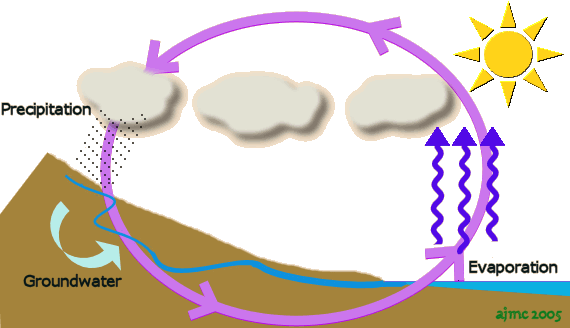The Earth’s hydrological cycle is the global mechanism that transfers water from the oceans to the surface and from the surface, or subsurface environments, and plants to the atmosphere that surrounds our planet.
The principal natural component processes of the hydrological cycle are: precipitation, infiltration, runoff, evaporation and transpiration.
Human activities (settlements, industry, and agricultural developments) can disturb the components of the natural cycle through land use diversions and the use, reuse and discharge of wastes into the natural surface water and groundwater pathways.
The Earth’s atmosphere contains approximately 13,000 km³ of water. This represents 10% of the world’s freshwater resources not found in groundwater, icecaps or permafrost. However, of more importance is the fact that this vapour cycles in the atmosphere in a ‘global dynamic envelope’, which has a substantive annually recurring volume, estimated to be from 113,500 to 120,000 km³. These large volumes illustrate precipitation’s key role in renewing our natural water resources, particularly those used to supply natural ecosystems and rainfed crops.
When atmospheric precipitation reaches the ground, it divides into several sections, which pursue the terrestrial part of the hydrological cycle along different paths. Out of a total annual amount of 110,000 km³ of precipitation on the land surface, about 40,000 km³ is converted into surface runoff and aquifer recharge (blue water) and an estimated 70,000 km³ is stored in the soil and later returns to the atmosphere through evaporation and plant transpiration (green water).
The processes of evaporation and transpiration (evapotranspiration) are closely linked to the water found in soil moisture; these processes act as driving forces on water transferred in the hydrological cycle. Movement through soil and vegetation is large and accounts for 62% of annual globally renewable freshwater.
About 40% of the precipitation that falls on land comes from ocean-derived vapour. The remaining 60% comes from land-based sources.
In a temperate climate, 33% of the total precipitation generally either returns by evaporation or evapotranspiration back into the atmosphere, 33% becomes surface water through runoff, and 33% recharges groundwater.
In a semi-arid climate, 50% of the total precipitation either returns by evaporation or evapotranspiration back into the atmosphere, 30% becomes surface water through runoff, and 20% recharges groundwater.
In an arid climate, 70% of the total precipitation either returns by evaporation or evapotranspiration back into the atmosphere, 29% becomes surface water through runoff, and only 1% recharges groundwater.
The section “Did You Know…?” is taken from the 2nd United Nations World Water Development Report, ‘Water, a shared responsibility‘.


